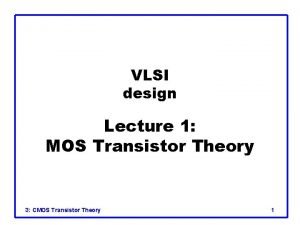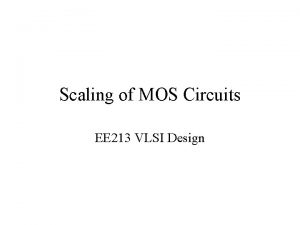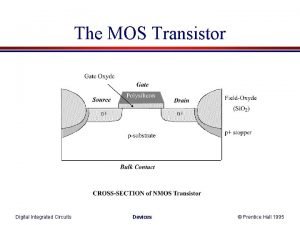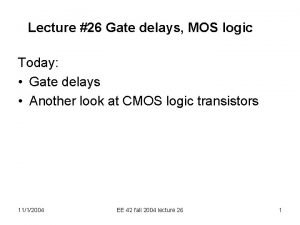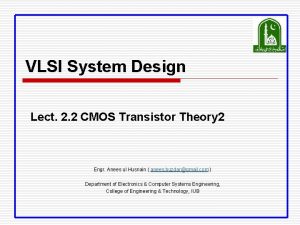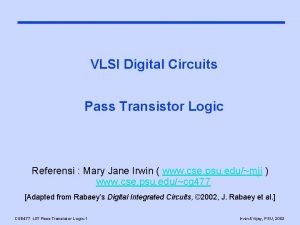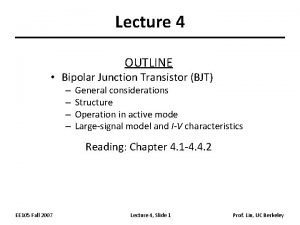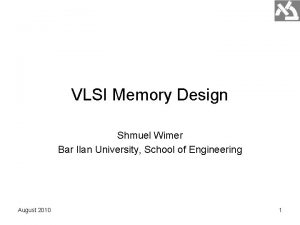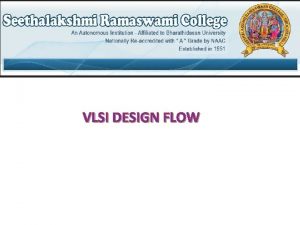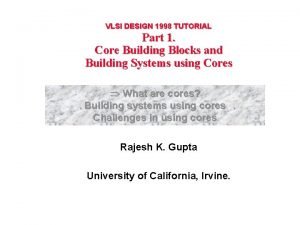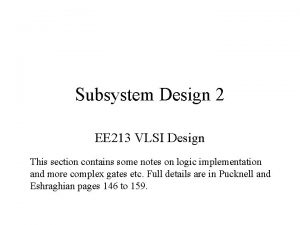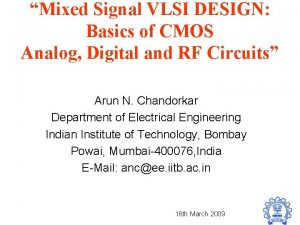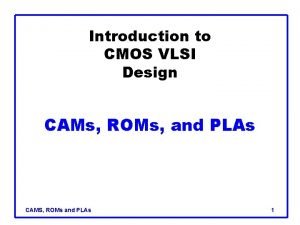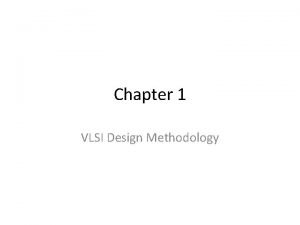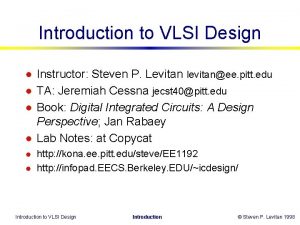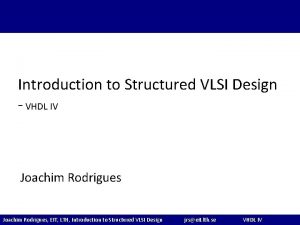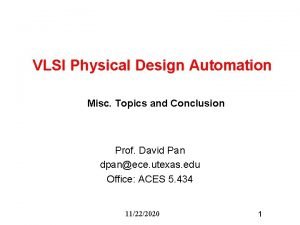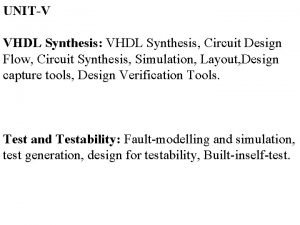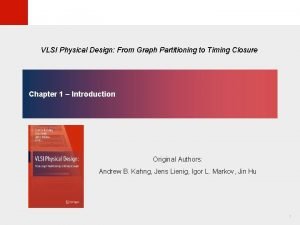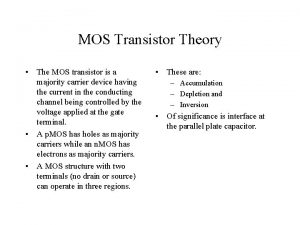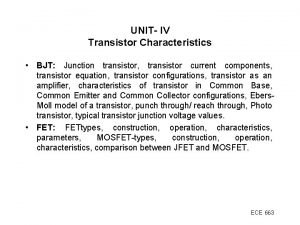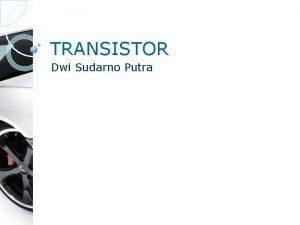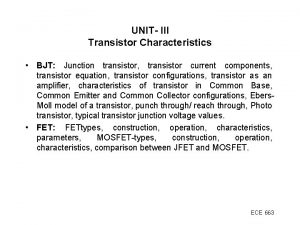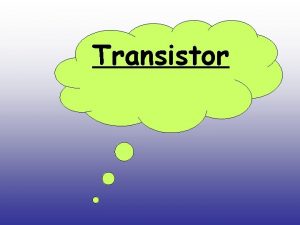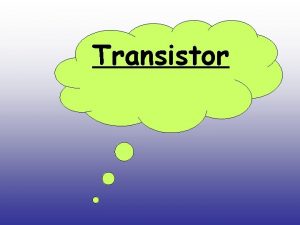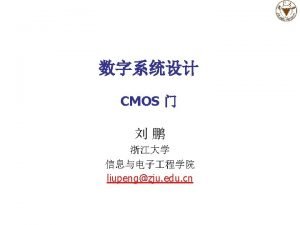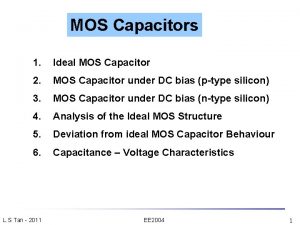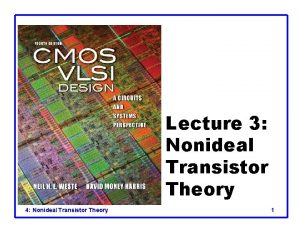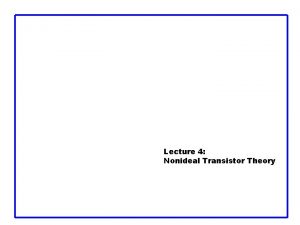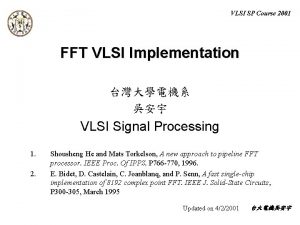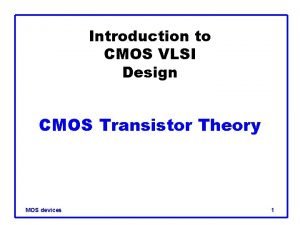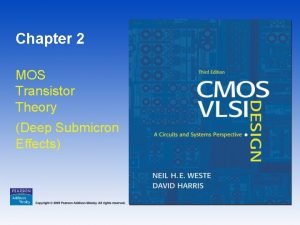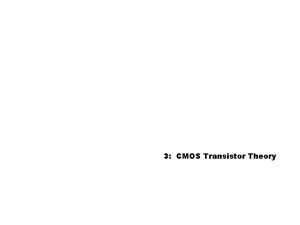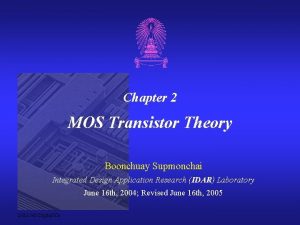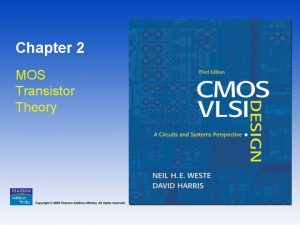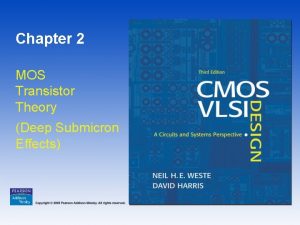VLSI design Lecture 1 MOS Transistor Theory 3


























- Slides: 26

VLSI design Lecture 1: MOS Transistor Theory 3: CMOS Transistor Theory 1

Outline q q Introduction MOS Capacitor n. MOS I-V Characteristics p. MOS I-V Characteristics 3: CMOS Transistor Theory CMOS VLSI Design 2

Introduction q Treatment of transistors as something beyond ideal switches q An ON transistor passes a finite amount of current – Depends on terminal voltages – Derive current-voltage (I-V) relationships q Transistor gate, source, drain all have capacitance – I = C (DV/Dt) -> Dt = (C/I) DV – Capacitance and current determine speed 3: CMOS Transistor Theory CMOS VLSI Design 3

MOS Capacitor q Gate and body form MOS capacitor q Operating modes – Accumulation – Depletion – Inversion 3: CMOS Transistor Theory CMOS VLSI Design 4

Terminal Voltages q Mode of operation depends on Vg, Vd, Vs – Vgs = Vg – Vs – Vgd = Vg – Vds = Vd – Vs = Vgs - Vgd q Source and drain are symmetric diffusion terminals – By convention, source is terminal at lower voltage – Hence Vds 0 q n. MOS body is grounded. First assume source is 0 too. q Three regions of operation – Cutoff – Linear – Saturation 3: CMOS Transistor Theory CMOS VLSI Design 5

n. MOS Cutoff q No channel q Ids = 0 3: CMOS Transistor Theory CMOS VLSI Design 6

n. MOS Linear q Channel forms q Current flows from d to s – e- from s to d q Ids increases with Vds q Similar to linear resistor 3: CMOS Transistor Theory CMOS VLSI Design 7

n. MOS Saturation q q Channel pinches off Ids independent of Vds We say current saturates Similar to current source 3: CMOS Transistor Theory CMOS VLSI Design 8

I-V Characteristics q In Linear region, Ids depends on – How much charge is in the channel? – How fast is the charge moving? 3: CMOS Transistor Theory CMOS VLSI Design 9

Channel Charge q MOS structure looks like parallel plate capacitor while operating in inversion – Gate – oxide – channel q Qchannel = 3: CMOS Transistor Theory CMOS VLSI Design 10

Channel Charge q MOS structure looks like parallel plate capacitor while operating in inversion – Gate – oxide – channel q Qchannel = CV q C= 3: CMOS Transistor Theory CMOS VLSI Design 11

Channel Charge q MOS structure looks like parallel plate capacitor while operating in inversion – Gate – oxide – channel q Qchannel = CV Cox = eox / tox q C = Cg = eox. WL/tox = Cox. WL q V= 3: CMOS Transistor Theory CMOS VLSI Design 12

Channel Charge q MOS structure looks like parallel plate capacitor while operating in inversion – Gate – oxide – channel q Qchannel = CV Cox = eox / tox q C = Cg = eox. WL/tox = Cox. WL q V = Vgc – Vt = (Vgs – Vds/2) – Vt 3: CMOS Transistor Theory CMOS VLSI Design 13

Carrier velocity q Charge is carried by eq Carrier velocity v proportional to lateral E-field between source and drain q v= 3: CMOS Transistor Theory CMOS VLSI Design 14

Carrier velocity q Charge is carried by eq Carrier velocity v proportional to lateral E-field between source and drain q v = m. E m called mobility q E= 3: CMOS Transistor Theory CMOS VLSI Design 15

Carrier velocity q Charge is carried by eq Carrier velocity v proportional to lateral E-field between source and drain q v = m. E m called mobility q E = Vds/L q Time for carrier to cross channel: – t= 3: CMOS Transistor Theory CMOS VLSI Design 16

Carrier velocity q Charge is carried by eq Carrier velocity v proportional to lateral E-field between source and drain q v = m. E m called mobility q E = Vds/L q Time for carrier to cross channel: – t=L/v 3: CMOS Transistor Theory CMOS VLSI Design 17

n. MOS Linear I-V q Now we know – How much charge Qchannel is in the channel – How much time t each carrier takes to cross 3: CMOS Transistor Theory CMOS VLSI Design 18

n. MOS Linear I-V q Now we know – How much charge Qchannel is in the channel – How much time t each carrier takes to cross 3: CMOS Transistor Theory CMOS VLSI Design 19

n. MOS Linear I-V q Now we know – How much charge Qchannel is in the channel – How much time t each carrier takes to cross 3: CMOS Transistor Theory CMOS VLSI Design 20

n. MOS Saturation I-V q If Vgd < Vt, channel pinches off near drain – When Vds > Vdsat = Vgs – Vt q Now drain voltage no longer increases current 3: CMOS Transistor Theory CMOS VLSI Design 21

n. MOS Saturation I-V q If Vgd < Vt, channel pinches off near drain – When Vds > Vdsat = Vgs – Vt q Now drain voltage no longer increases current 3: CMOS Transistor Theory CMOS VLSI Design 22

n. MOS Saturation I-V q If Vgd < Vt, channel pinches off near drain – When Vds > Vdsat = Vgs – Vt q Now drain voltage no longer increases current 3: CMOS Transistor Theory CMOS VLSI Design 23

n. MOS I-V Summary q Shockley 1 st order transistor models 3: CMOS Transistor Theory CMOS VLSI Design 24

Example q 0. 6 mm process (Example) – From AMI Semiconductor – tox = 100 Å – m = 350 cm 2/V*s – Vt = 0. 7 V q Plot Ids vs. Vds – Vgs = 0, 1, 2, 3, 4, 5 – Use W/L = 4/2 l 3: CMOS Transistor Theory CMOS VLSI Design 25

p. MOS I-V q All dopings and voltages are inverted for p. MOS q Mobility mp is determined by holes – Typically 2 -3 x lower than that of electrons mn – 120 cm 2/V*s in AMI 0. 6 mm process q Thus p. MOS must be wider to provide same current – In this class, assume mn / mp = 2 3: CMOS Transistor Theory CMOS VLSI Design 26
 Mos transistor theory
Mos transistor theory Scaling factor in vlsi
Scaling factor in vlsi Cmos vlsi design lecture notes
Cmos vlsi design lecture notes Velocity saturation
Velocity saturation Mos transistor
Mos transistor Vlsi transistor
Vlsi transistor Pass transistor in vlsi
Pass transistor in vlsi Bjt transistor current equations
Bjt transistor current equations Current components in bjt
Current components in bjt 01:640:244 lecture notes - lecture 15: plat, idah, farad
01:640:244 lecture notes - lecture 15: plat, idah, farad Memory design in vlsi
Memory design in vlsi Vlsi design flow y chart
Vlsi design flow y chart Biucache
Biucache Subsystem design in vlsi
Subsystem design in vlsi Mixed signal vlsi design
Mixed signal vlsi design Vlsi
Vlsi Intro to vlsi
Intro to vlsi Y chart in vlsi design
Y chart in vlsi design Cmos design rules
Cmos design rules Cpld in vlsi
Cpld in vlsi Ad hoc testable design techniques in vlsi
Ad hoc testable design techniques in vlsi Introduction to vlsi
Introduction to vlsi Structured vlsi design
Structured vlsi design Physical design
Physical design Vlsi design styles
Vlsi design styles Vhdl design flow
Vhdl design flow Vlsi design flow
Vlsi design flow
